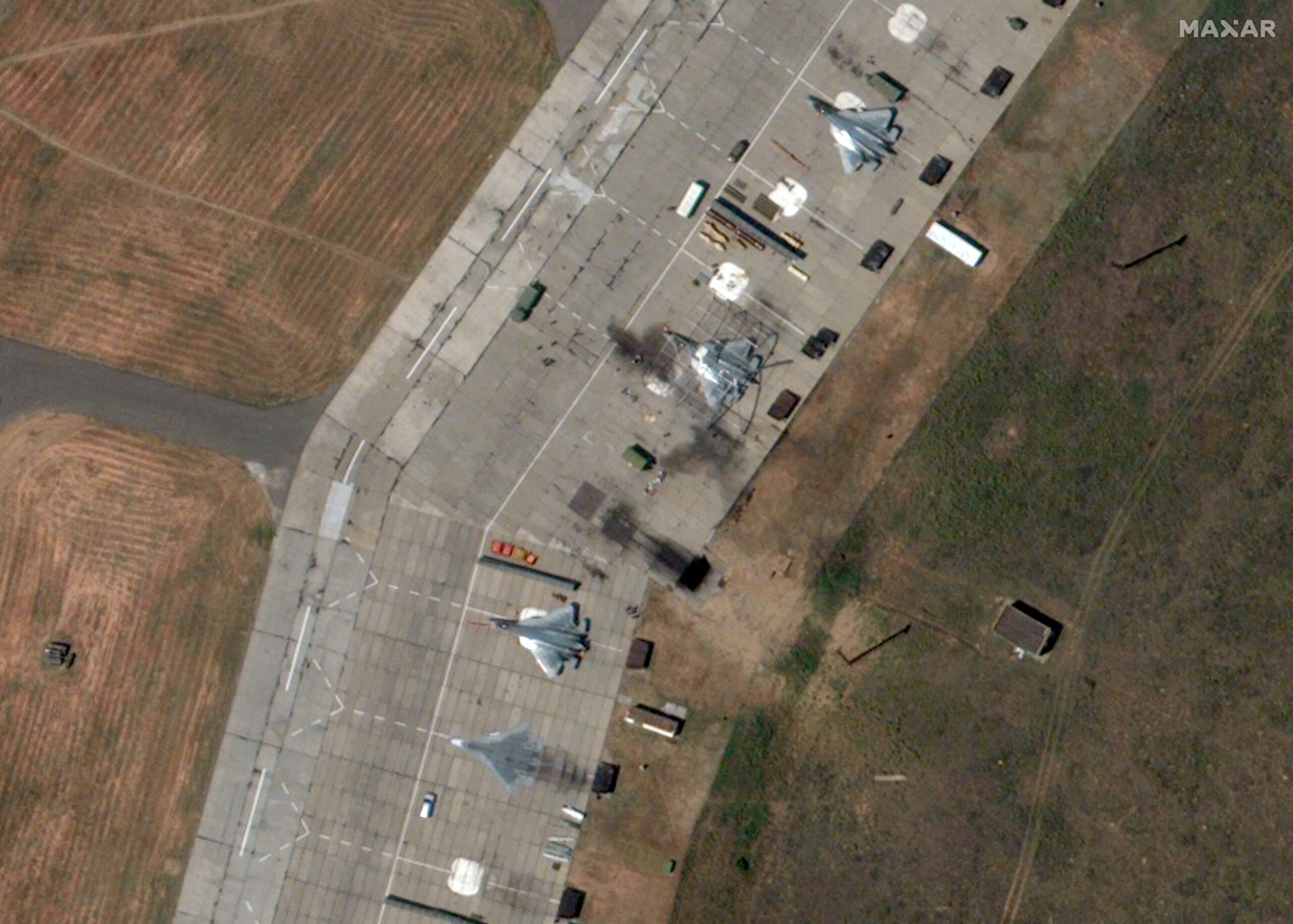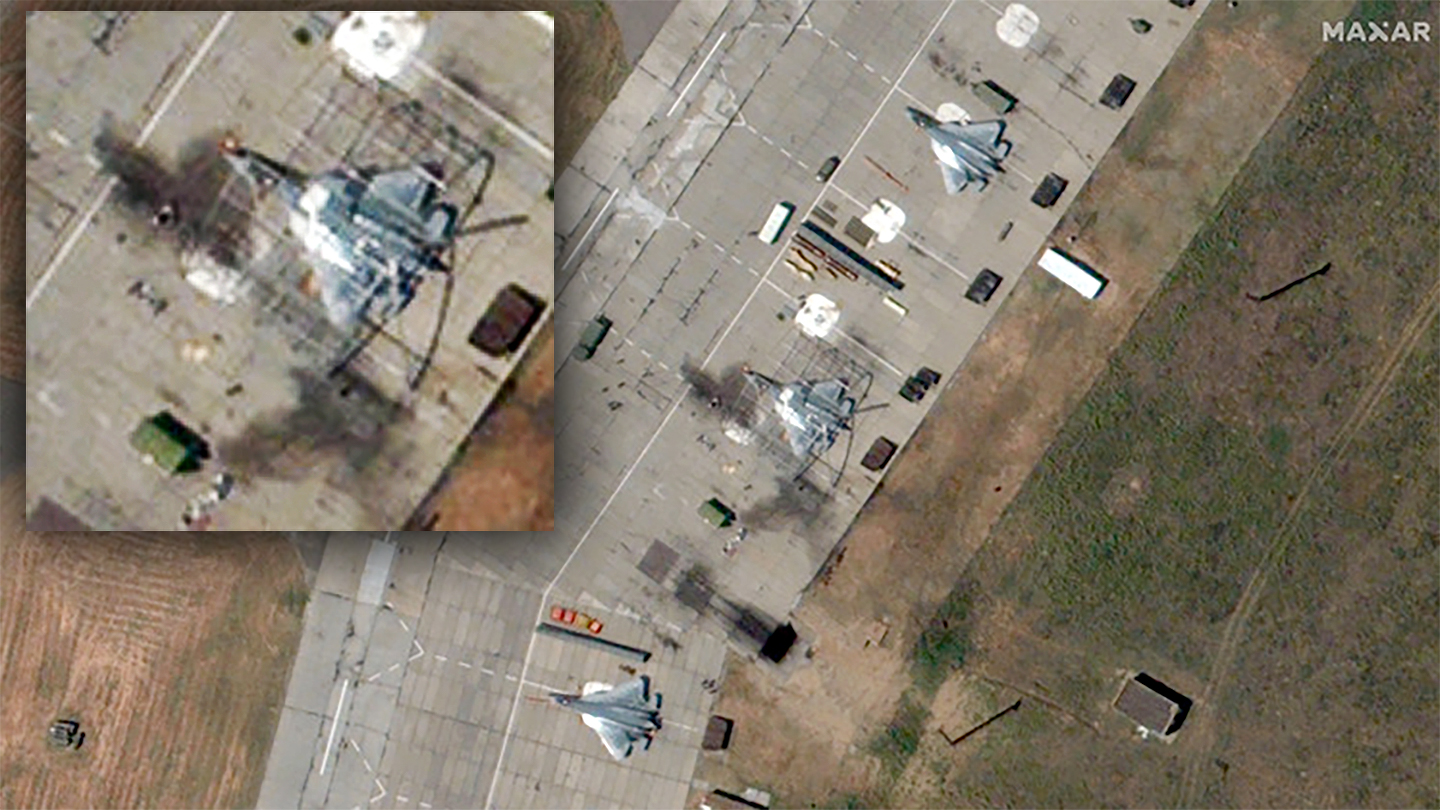New satellite images obtained by The War Zone from Maxar Technologies on Monday show a clearer view of the Su-57 Felon next-generation fighter targeted in a Ukrainian drone attack on an airbase deep inside Russia that we wrote about yesterday. The images also show three Felons, Moscow’s most advanced warplane, on the apron at Akhtubinsk Air Base, located about 365 miles from the front lines, in Russia before and after the June 8 attack. Most importantly, the images posted Sunday by Ukraine’s Defense Intelligence Directorate (GUR) were tightly focused on the one Felon they claimed was damaged, but these wider before and after views offer much more context and opportunity for comparative analysis.
The aircraft in the middle of the new Maxar imagery is the one Ukraine said was damaged. It is under a framework for a shelter without any covering. In a June 7th image, before the attack, there is a slight discoloration on the apron to the left of the aircraft, but no scorch marks or craters. There is also a silhouette of an Su-57 painted on the apron, which Russians have been using in an attempt disrupt Ukrainian strike operations. You can read more about that effort here.

The second image Maxar sent us today shows the same Felons parked on the apron after the June 8 attack. Like the GUR image, it shows burn marks and what is clearly now a small crater to the left of the cockpit of the middle jet. As we noted yesterday, the blast and especially the shrapnel from such a nearby detonation would have very likely riddled the plane with holes and caused other damage. Another scorch mark is seen towards the rear of the aircraft, with what appears to be a small impact hole in the concrete.
There is also still the white blotch on the top of the fuselage behind the cockpit. It is unclear what this is. It’s possible it is a tarp of some kind, potentially covering damage. The other white streak-like anomaly seen emanating from the inner wing area appears to be sun glare. The GUR image also had this, which was confusing at the time, but now makes sense in context of the new imagery that includes the other jets nearby.

On Sunday, Lt. Gen. Kyrylo Budanov, head of the GUR, told us that his organization carried out a drone attack on that airbase that damaged one and possible two Felons.
These new images do put more weight on the possibility that primary Su-57 in question was damaged. The crater is clearly defined and in very close proximity to the jet.
As we reported on Sunday, after the attack, the Russian Aerospace Forces-connected Fighterbomber Telegram channel complained bitterly about the lack of proper shelters to ward off such drone strikes. Those complaints continued on Monday, this time from an unnamed Russian colonel claiming 20 years in uniform. He called for an investigation by the Russian Aerospace Forces and the Department Voeinnoi Konttrazvedki (DVKR), the FSB’s Military Counterintelligence unit.
“I appeal to the commanders of the airbases of the Russian Aerospace Forces and the heads of the DVKR departments supervising them,” the colonel complained to the Grey Zone Telegram channel. “WHAT OR WHOSE INSTRUCTIONS DO YOU NEED TO CREATE COVERS FOR OUR AIRCRAFT EQUIPMENT? WHAT ARE YOU WAITING FOR? BY YOUR INACTION YOU ARE SUPPORTING THE ENEMY!”
“I realize that the creation of solid, underground or above-ground reinforced concrete shelters may be an issue that cannot be resolved at your level,” the colonel continued. “At the same time, taking into account that the main damage to our aircraft comes from primary and secondary fragments formed after explosions of UAVs and enemy missiles, to preserve aircraft equipment in most cases, aluminum hangars or hangars made of sandwich panels will be sufficient (the price of one such hangar with an area of 12x6x45 meters less than 1 million rubles [$11,245]).”
Even the type of shelters the Russian colonel described, as we previously noted, would provide a layer of protection that can help protect from low-yield drone strikes and make targeting much more challenging. As the voices of complaint rise amid the ongoing Ukrainian drone onslaught against airbases deep inside Russia, it will be interesting to see if Moscow begins to better protect its aircraft.
Contact the author: howard@thewarzone.com
